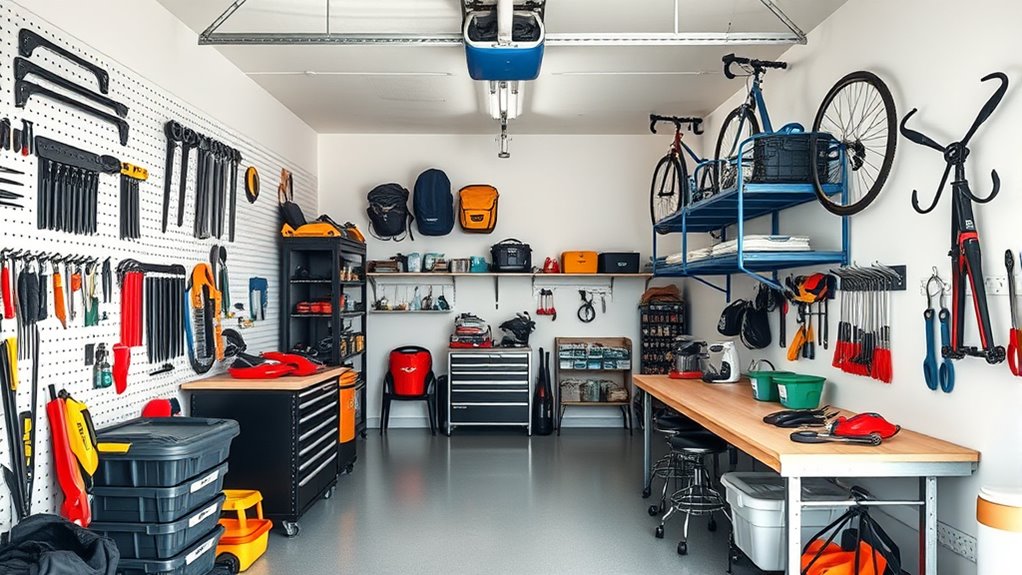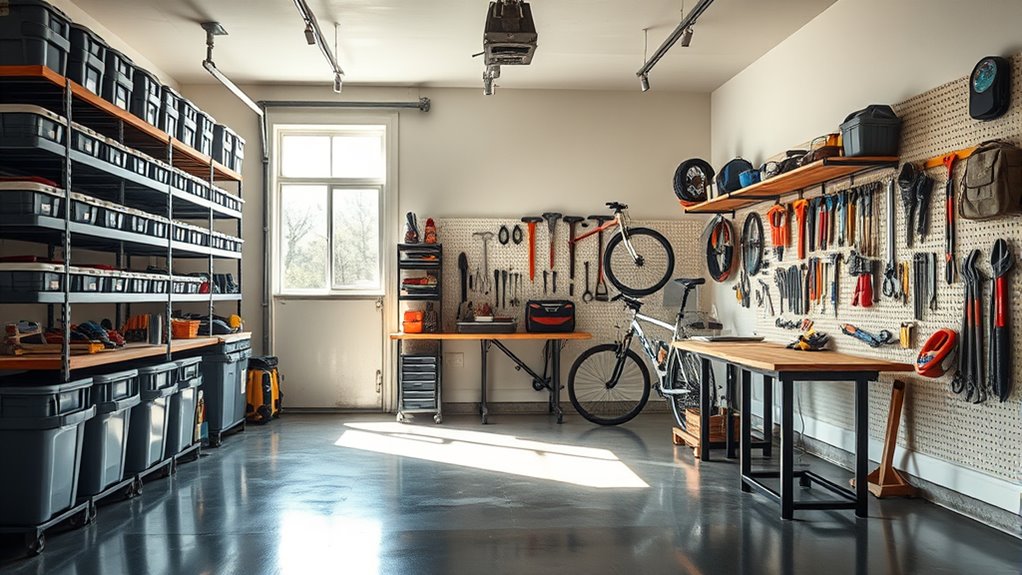To organize your garage for DIY projects, start by decluttering and creating dedicated zones for tools, materials, and hobbies. Use modular shelves, wall-mounted racks, and labeled storage bins to keep things accessible and tidy. Measure your space carefully to guarantee all storage fits without blocking pathways. Keep frequently used items within reach and store less-used equipment higher up. For more tips on transforming your garage into a functional workspace, continue exploring useful strategies.
Key Takeaways
- Assess your tools and supplies to create designated zones for easy access and better workflow.
- Use modular shelving, wall-mounted racks, and bins to maximize space and keep items organized.
- Measure your garage carefully to select appropriately sized storage solutions that don’t obstruct movement.
- Regularly declutter, donate, or recycle unused items to maintain a tidy and functional space.
- Prioritize safety by keeping pathways clear, storing heavy items higher, and labeling storage areas clearly.

A well-organized garage can transform your space into a functional and safe area. As a DIY enthusiast, you know how clutter can slow down projects and make tools hard to find. Investing in smart organization can save you time, protect your tools, and create a workspace that sparks creativity. Modular systems are trending because they offer flexible solutions that grow with your needs. Shelves, bins, baskets, and totes are practical choices for containing items and keeping your garage tidy. By categorizing tools and supplies, you’ll streamline your workflow and avoid wasting time searching for that one screwdriver or drill bit.
Smart modular storage solutions keep your garage organized, safe, and ready for any DIY project.
Start by evaluating what you use most often. Create dedicated zones for hand tools, power tools, and materials. This helps in planning your storage and ensures everything is accessible when you need it. Wall-mounted racks are popular for keeping bulky items off the floor and freeing up space for projects or parking. Measure your garage carefully to select storage units that fit perfectly and don’t obstruct movement. Repurposing household items, like using old bins or crates, can save money and add a personalized touch to your setup.
Decluttering is essential before you start organizing. Remove items you no longer need or use, and consider donating or recycling them. Regularly review your setup to make adjustments as your projects evolve. This ongoing maintenance prevents clutter from creeping back and keeps your tools in top condition. When arranging your garage, think about accessibility—place frequently used tools where they can be reached easily, and store seldom-used items higher up or in less accessible spots. Clear pathways and safe storage prevent accidents, especially when working with sharp or heavy equipment.
For DIY projects, having a well-organized space makes a significant difference. Create specific zones for woodworking, automotive work, or crafting, tailored to your hobbies. This not only boosts productivity but also enhances safety by keeping dangerous tools well-controlled. Versatile storage options allow you to adapt your garage as your interests change, ensuring long-term functionality. Proper labels, clear signage, and consistent organization make it easier to maintain your space over time. Additionally, understanding the importance of contrast ratio can help you select project lighting that enhances visibility and accuracy during detailed work.
Ultimately, a tidy garage maximizes your workspace, boosts safety, and makes DIY projects more enjoyable. With a strategic approach to layout, storage, and decluttering, you’ll turn your garage into a well-oiled hub of creativity and productivity. Keeping everything organized requires effort, but the benefits—more efficient projects, a safer environment, and a more attractive space—are well worth it.
Frequently Asked Questions
How Often Should I Reassess My Garage Organization System?
You should reassess your garage organization system regularly to keep it functional and clutter-free. Most people find that quarterly reviews work well, especially after heavy use during seasons like spring or fall. More frequent check-ins, like monthly or bi-weekly, can help if your garage sees heavy activity or seasonal changes. Set reminders to stay consistent, and don’t forget to adjust storage as your needs and tools evolve over time.
What Are Eco-Friendly Storage Options for My Garage?
Eco-friendly storage options in your garage include using recycled-material bins and sustainable shelving from reclaimed wood or bamboo. Repurposing old furniture into storage units reduces waste, while CARB-compliant cabinets guarantee eco-friendly sourcing. Biodegradable containers help cut plastic waste, and modular or vertical storage maximizes space efficiently. Choosing these eco-conscious solutions not only keeps your garage organized but also supports sustainability and reduces your environmental impact.
How Can I Prevent Rust on Metal Tools and Equipment?
To keep your metal tools rust-free, you should clean them regularly to remove dirt and debris, then apply a thin layer of oil for protection. Store your tools in a dry, well-ventilated space, and consider using rust-inhibiting sprays like WD-40 or specialized coatings. Keep humidity low with a dehumidifier, and inspect your tools frequently to catch rust early. Proper storage and maintenance are key to preventing rust.
What Are Space-Saving Ideas for Small Garages?
You can save space in your small garage by maximizing vertical and wall space. Install ceiling hooks, overhead racks, and wall-mounted pegboards to hang tools, bikes, and seasonal items. Use stacking bins and modular systems for efficient storage. Adjust shelving to fit varied items, and label everything for quick access. Regularly clean and rotate items to keep your garage organized and clutter-free, making the most of limited space.
How Do I Organize Seasonal Items Efficiently?
Think of your garage like a well-tended garden, where seasonal items are the plants needing care. To organize efficiently, categorize items by season, then store infrequently used gear on ceiling racks or in cabinets. Use labels for quick access and keep frequently used items handy. Regularly declutter, rotate seasonal gear as needed, and adapt storage solutions to fit your space. This keeps your garage functional and clutter-free year-round.
Conclusion
By implementing these garage organization tips, you’ll create a space that’s both functional and enjoyable to work in. A well-organized garage not only saves you time but also boosts your motivation to jump into DIY projects. Believe it or not, studies show that a tidy environment can improve your productivity and reduce stress. So, take action today—your DIY adventures will be more fun and rewarding when your garage is in top shape!










